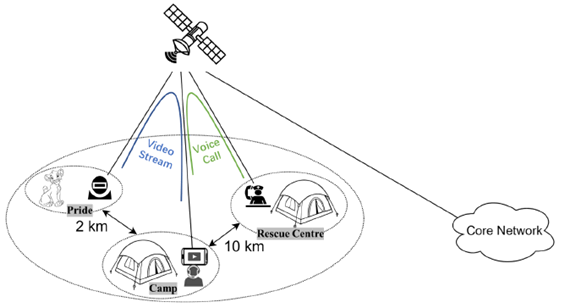Content for TR 22.865 Word version: 19.2.0
5.8 Use case on enabling multiple communication services between UEs
5.8.1 Description
5.8.2 Pre-conditions
5.8.3 Service Flows
5.8.4 Post-conditions
5.8.5 Existing features partly or fully covering use case functionality
5.8.6 Potential New Requirements needed to support the use case
...
...
5.8 Use case on enabling multiple communication services between UEs p. 23
5.8.1 Description p. 23
The behaviours and trace of wild animals are the evidence of nature science. Researchers often use camouflage cameras blending in with their surroundings to observe wild animals. Meanwhile, researchers need to stay far enough away from the wild animals in order not to disturb their normal behaviour.
African savannah is a good place for research to observe and study lions. Usually, the researchers are camped far from the pride, and manipulate several mobile camouflage cameras to approach the pride and take videos for them. The camera with inner analysis functions can identify some typical behaviours and send corresponding notifications to the researchers. In this way, researchers can record and trace the pride and call the rescue centre for help when the lions get wounded.
In fact, to safeguard the ecology of wild animals, there is always no terrestrial network, and walkie-talkies are widely used for short distance communication there. However, because the camouflage camera, the rescue centre and the camp are usually far away from each other, the communication between them can only be easily realized with the help of satellites. In general, both the video stream and the voice call need to be transmitted to a nearby terrestrial network first, so it will affect communication efficiency, especially in emergency situations.
5.8.2 Pre-conditions p. 23
There is no terrestrial network in the African savannah, but it is covered and served by the satellites owned by Satellite Operator SatA.
TerA which is a terrestrial network operator contracts with SatA to allow communication services between devices in the African savannah via satellite. That is, devices can communication directly via satellite without going through the ground network.
To support multiple communication services simultaneously, TerA provides a variety of plans for different purpose, e.g., video stream, voice call, etc.
Emily is the leader of the researching team. All devices in the camp are subscribers of TerA. Emily signs video stream plan for every camera which is 2km away from Emily's camp, and she signs both video stream and voice call plan for her mobile phone.
Vincent is an assistant at the rescue centre which is 10km away from the camp, and he is also a subscriber of TerA with voice call plan.

Figure 5.8.2-1: Multiple communication services via satellite without going through the ground network
(⇒ copy of original 3GPP image)
(⇒ copy of original 3GPP image)
5.8.3 Service Flows p. 24
- One camera detects an injured lion, then it sends a notification to Emily's phone via a satellite.
- After receiving the notification, Emily opens the "Cam" App on her phone to watch the live video captured by the camera. The video stream from the camera to Emily's phone is routed through the satellite.
- By watching the video, Emily notices that the injured lion is being driven out of this pride. So Emily tracks the injured lion through the mobile camouflage camera. At the same time, she calls Vincent.
- Vincent answers the phone and this voice call is also routed through the same satellite.
- During the call, the satellite detects that the quality of voice call is impaired, so it re-choose a lower communication quality level for the video stream because of limited satellite resources and service priority.
5.8.4 Post-conditions p. 24
Emily can watch real-time video with lower resolution from the camera and keep the call with Vincent at the same time.
Both the video stream and voice call can be routed through the same satellite without being transmitted to the remote core network.
5.8.5 Existing features partly or fully covering use case functionality p. 24
There are a few related requirements specified in TS 22.261, which have been described as:
The 5G system shall be able to support E2E (e.g. UE to UE) QoS for a service.
For a 5G system with satellite access, the following requirements apply:
- The 5G system shall support service continuity between 5G terrestrial access network and 5G satellite access networks owned by the same operator or owned by different operators having an agreement.
- A 5G system with satellite access shall be able to select the communication link providing the UE with the connectivity that most closely fulfils the agreed QoS.
- A 5G system with satellite access shall enable roaming of UE supporting both satellite access and terrestrial access between 5G satellite networks and 5G terrestrial networks.
5.8.6 Potential New Requirements needed to support the use case p. 25
[PR 5.8.6-001]
Subject to regulatory requirements and operator's policy, the 5G system with satellite access shall be able to provide a mechanism for QoS control of the communication between UEs using satellite access without going through the ground network.
[PR 5.8.6-002]
Subject to regulatory requirements and operator's policy, the 5G system with satellite access shall be able to support different types of communication (e.g. services including unicast, multicast, broadcast) using satellite access without going through the ground network.